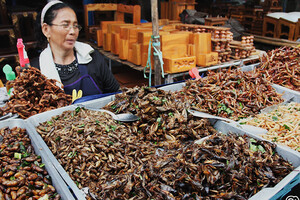Scientists call insects an important source of protein.

Amru Aveishe and Christine Picard of Indiana University said that the use of insects can help humanity cope with climate change . The scientists' article is the subject of discussion at this year's World Economic Forum in Davos.
Scientists say we are accustomed to seeing animals and plants as the main source of protein. We get it from meat, eggs, tofu, beans and nuts. But there is a category of stable and nutritious protein that remains unnoticed: insects.
Read also: Polluted air prevents insects from finding flowers – scientists
According to researchers, most of us are not used to perceiving insects as food sources. But the difference between protein sources is actually small. For example, plant proteins lack some essential amino acids that animals have. The differences between insects and other sources of protein lie mainly in the environmental and cultural spheres.
Scientists cite five reasons why the use of insects is a great alternative to conventional sources of protein that can reduce the carbon footprint of mankind./p>
Edible insects can be a source of the same amount of protein as animals
Thus, insects contain from 9.96 to 35.2 g of protein per 100 g, compared with 16.8-20.6 g in animals. Of course, the protein content is not the same in all insects. Yes, the “stars” in its number are crickets, some species of ants and mealworms. One of the easiest ways to incorporate insect protein into your daily diet is to add cricket protein powder as a dietary supplement.
Animals require less care and housing than cattle
Insects require less land, less fodder, transport fuel and less human labor than livestock, leaving less carbon footprint. Plants, on the other hand, do not produce greenhouse gases, but require the use of land, water and machinery for production and transportation, which releases carbon.
Available protein is running out
It is expected that by 2050 the world's population will reach 10 billion people, the need for protein will exceed the capacity to obtain it. Protein is vital to our body, without it it can not produce the necessary amino acids.
To survive in the long run, humanity needs to increase food production while reducing carbon emissions. This requires truly innovative approaches to food production and perception.
Insects are part of an important ecological cycle
Insects can feed on organic waste from other production processes, thus preventing additional waste from entering landfills. This is called circular agriculture, the removal of materials from landfills that produce 20% of global anthropogenic methane emissions and are the second largest producers of greenhouse gases. Using insects for other functions closes the cycle and has a positive effect on climate change.
The cycle of product development will help reduce greenhouse gas emissions, as recyclable materials will no longer end up in landfills, producing methane and other harmful gases.
You can start small and gradually increase consumption. Most people probably won't be ready to eat an insect right away. But there are other ways to introduce insect protein into the food chain. For example, you can introduce insects into the diet of animals and then use their meat for food.
This will make a significant contribution to combating climate change. Approximately 45% of greenhouse gas emissions from livestock are from animal feed production.
The diet of chickens before their domestication included insects. That is, instead of growing corn for animal feed, we could grow chickens on an insect diet. The result is chicken with the same taste, but less negative impact on the environment.
Converting agriculture to feed using insect protein is an effective way to affect the environment.
See special topic: Davos 2022: “Green Transition” and digitalization will determine the labor market of the future At the same time, the “traditional spheres” of the economy remain equally important. WMO has made a disappointing forecast for global warming The chances that the planet's temperature will be 1.5 degrees above pre-industrial levels have increased. South Asia – record heat: there may be more problems than COVID-19 Many people in Asia are now suffering from heat stroke. Greenland's glaciers are melting “from the bottom up”, which accelerates their refinement – scientists Researchers call the ice sheet “the largest dam in the world”. DW: A quarter of the world's land could turn into a desert by the middle of this century – scientists predict Proper use of land and water resources is the only way to prevent fertile soils from drying out.




